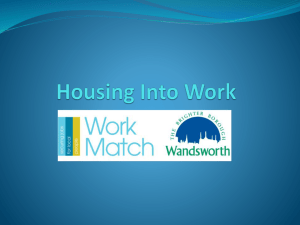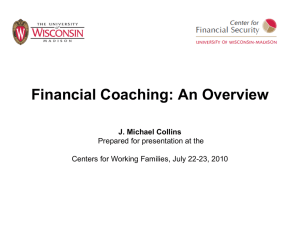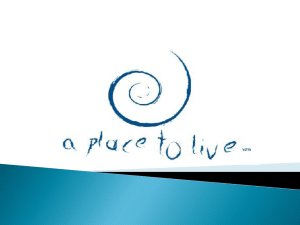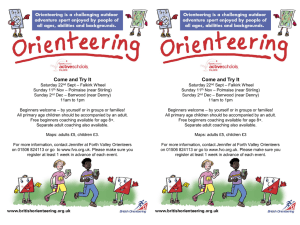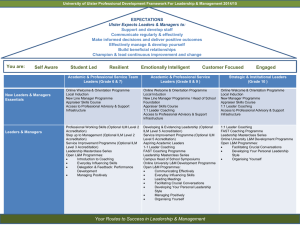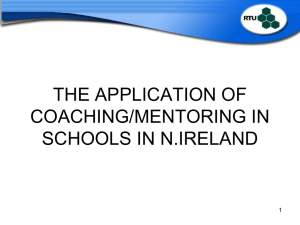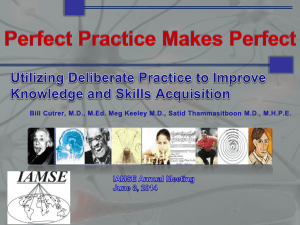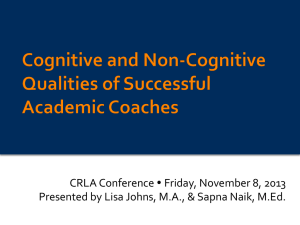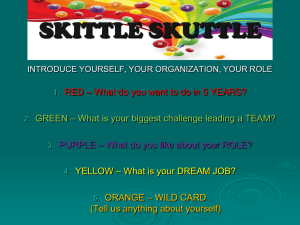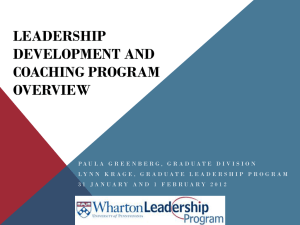We Want to Live It! - Quality Forum 2015
advertisement
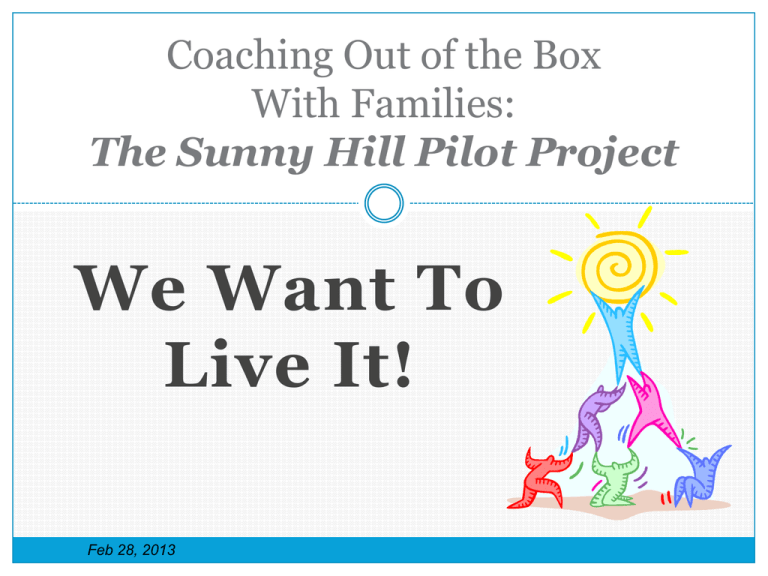
Coaching Out of the Box With Families: The Sunny Hill Pilot Project We Want To Live It! Feb 28, 2013 Project Team & Partnerships • Alda Antunes Silvestre, RN BSN MSN • Sandy Tatla, MSc. Candidate, MOT, • Shelley Woodman, RN, BScN • Dori Van Stolk, RN, BScN, MA, CEC • Tal Jarus, Phd, OTR • Susan Greig, Partners in Care Family Liaison • Meghan Husson, MOT Candidate • Stacey Burnes, MOT Candidate Outline • Literature Background • The Sunny Hill Experience • Coaching out of the Box • Pilot Project • Preliminary Findings • Lessons Learned • Closing Literature Review: The Gap ① Family involvement is frequently identified as a key element of successful rehab Yet, we don’t know how clinicians can best involve them1 ② Family centered care & effective communication were among the top quality of care indicators for rehabilitation of children with traumatic brain injury2 ③ A strong need exists for improved communication skills3 Literature continued… Health care professionals need to work together and also with the patients & their families5 Disrespect or insensitivity reported more commonly than technical errors in diagnosis and treatment4 Approaches to Improve Communication Various methods used to improve communication skills, including: training workshops run by experts lectures and education sessions interviews and questionnaires role playing and feedback in small groups shared decision-making training Our Challenge – “Connecting With” Families The Chinese Characters for Listening: 1. Ear Gather 2. Eye Perceive 3. Heart Sense 4. King Respect Who you need to be Curious Supportive Accepting Focused Committed How: 5 steps Identify Discover Strategize Clear the way Recap Level 1 Listening…………………………………………”Scratching The Surface” Level 2 Listening…………………………………………What is said – Content Level 3 Listening…………………………………………What We Feel + Think What Skills To Use Listening- 3 Levels Encouraging Questioning Requesting Action Planning Coaching Fundamentals Project Aim 1. To demonstrate the feasibility of coach training 2. Improve family & service provider: o Satisfaction o Communication o Engagement o Collaboration ….To ultimately facilitate a successful rehabilitation experience Participants Multi-disciplinary Acute Rehabilitation Team in pediatric rehabilitation centre 45 health care professionals Family representatives Intervention Workshop 1: • Core Coaching Competencies & the Case for Coaching Workshop 2: • Who you need to be 2 day Coaching Training Practice, practice… and more practice! 6 hours Triad Practice 1. 2. 3. 4. 5. Naming Triggers Taming Triggers Learning Language Yours, Mine & Ours: Shared Goals Learning in relationship 5 Learning Burst Sessions Mixed Methods Evaluation Quantitative: Pre & Post Intervention Qualitative: Post Intervention Feasibility 1:1 qualitative interview with families present pre & post (n=1) Measures of Processes of CareService Providers (MPOC-SP) Study-Specific Coaching Skills Questionnaire Focus groups: Service providers Tracking of Communication Related Safety Events Measures of Processes of CareFamilies (MPOC) Focus groups: Families Preliminary Results Feasibility Participation 93% participation in coaching workshops Triads still in process @ 5 months Learning Burst workshops in process 1st burst: 75% attendance 2nd burst: 43% attendance (nursing was missing due to staffing issues) Budget Ongoing facilitation needs Anecdotal results Satisfaction Communication Engagement Collaboration Lessons Learned Family representation was critical to the program’s success All stakeholders need to buy-in Recognizing the different work flows of a multidisciplinary team Learning as a team was key to providing a shared language & common approach to care Practicing the skills & follow-up is critical Facilitating the sustainability of coaching within our team Next Steps….. “Something is happening”…… synergy is occurring as team members learn & journey together Closing Have an understanding of: Literature & Practice Gaps in Communication Coaching Pilot Project Preliminary Findings from the project “The Road goes ever on and on Down from the door where it began. Now far ahead the Road has gone, And I must follow, if I can, Pursuing it with eager feet..” J.R. Tolkien Thank you! References 1. 2. 3. 4. 5. Levack, W.M.M., Siegert, R.J., Dean, S.G., & McPherson, K.M. (2009). Goal planning for adults with acquired brain injury: How clinicians talk about involving family.Brain Injury 23(3), 192-202. DOI: 10.1080/02699050802695582 Rivara, F.P, Ennis, S.K., Mangione-Smith, R., MacKenzie, E.J. & Jaffe, K.M. (2012).Quality of care indicators for the rehabilitation of children with traumatic brain injury. Arch Phys Med Rehabil, 93, 381-395. DOI:10.1016/j.apmr.2011.08.015 Lefebvre, H., Pelchat, D., Swaine, B., Ge’linas, I., & Levert, M.J. (2005). The experiences of individuals with traumatic brain injury families, physicians and health professionals regarding care provided throughout the continuum.Brain Injury 19(8), 585-597. DOI: 10.1080/02699050400025026 Jangland, E., Gunningberg, L., & Carlsson, M. (2009). Patients' and relatives' complaints about encounters and communication in health care: evidence for quality improvement. Patient Educ Couns, 75(2), 199-204. doi: 10.1016/j.pec.2008.10.007 Legare, F., Politi, M. C., Drolet, R., Desroches, S., Stacey, D., Bekker, H., & Team, Sdm-Cpd. (2012). Training health professionals in shared decision-making: an international environmental scan. Patient Educ Couns, 88(2), 159-169. doi: 10.1016/j.pec.2012.01.002 Extra Slides Next Steps Continuing coaching & learning bursts in the Fall as part of core competency development for our all staff in our setting Articulate & integrate these core competencies into our orientation pathway for new staff Explore strategies to continue to nurture & facilitate the integration of coaching into practice Move from individual awareness to more dialogue & work on the team Challenges/ Limitations Time Reflection – both in the moment & after Ongoing practice, mentorship, own coaching Integration + testing of new learning & skills in the moment; trial + error Recognition what skills/tools to use in the moment or context (eg. verbal aggression) Knowledge & wisdom Rehab: Philosophy of Care Maximizing people’s potential Def: “Habilitation includes all the activities & interactions that enable an individual with a disability to develop new abilities to achieve his/her maximum potential, whereas rehabilitation is the re-learning of previous skills, which often requires an adjustment to altered functional abilities and altered lifestyle. (Pg 4, Edwards, Hertzberg, Hays, + Youngblood, 1999, pediatric Rehab Nursing). Patient engagement is fundamental – the vehicle – to maximize rehab benefits (Lequerica & Kortte, 2010). Mixed Methods Evaluation Quantitative Pre & Post Evaluation: 1. 2. 3. 4. 5. Feasibility Measures of Processes of Care-Service Providers (MPOC-SP) Study-Specific Coaching Skills Questionnaire Tracking of Communication Related Safety Events Measures of Processes of Care-Families (MPOC) Qualitative Evaluation: 1. 2. 3. 4. Field notes throughout intervention 1:1 qualitative interview with families present pre & post (n=1) Focus groups: Service providers Focus groups: Families Feasibility Activity Attendance Dates 2-day coaching training 43/47 Sept & October 2012 6 hours coaching practice in triads ? Nov 2012 ongoing Learningburst 1: Identifying triggers ? January 2013 – 3 sessions offered / month Learning Burst 2: Taming triggers ? February 2013 Learning Burst 3: March 2013 Learning Burst 4: April 2013 Learning Burst 5: May 2013 Budget
